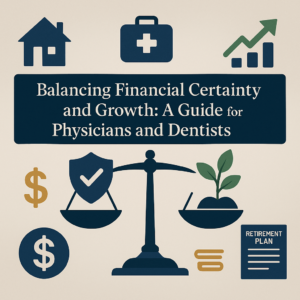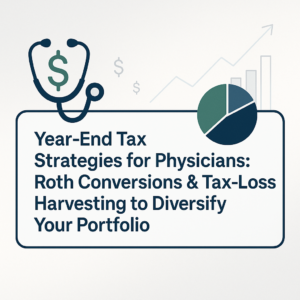For healthcare professionals — whether you’re a physician, dentist, pharmacist, physical therapist, or psychologist — planning for retirement is both crucial and complex. The demanding nature of your professions often results in irregular income and significant work-related stress, making proactive retirement planning all the more essential. One potential component of a well-rounded retirement strategy is annuities. Understanding what annuities are and how they work can help you make informed decisions for your financial future.
What are Annuities?
An annuity is a financial product that provides a steady income stream, typically used by individuals to ensure they do not outlive their retirement savings. Essentially, you pay a lump sum or a series of payments to an insurance company, and in return, they provide you with periodic payments.
Types of Annuities
Understanding the different types of annuities can help you decide which one might suit your needs best. Here are the basic types:
Fixed Annuities
Fixed annuities provide regular, guaranteed payments. The amount is set at the time of the contract and does not change, making them a low-risk option.
Variable Annuities
Payments from variable annuities fluctuate based on the performance of investments selected by the policyholder, such as stocks and bonds. This introduces some level of risk but may offer higher returns.
Indexed Annuities
Indexed annuities are tied to a market index, like the S&P 500. Your return is based on the performance of that index, often with a cap and a floor to limit both potential gains and losses.
Immediate Annuities
Immediate annuities start payouts almost immediately after a lump sum is paid. This might be ideal for a healthcare professional close to retirement who wants to convert a portion of savings into a secure income stream.
Deferred Annuities
Deferred annuities, on the other hand, begin payment at a later stage, often aligning with retirement years.
Benefits of Annuities
Guaranteed Income for Life
Annuities can provide dependable income throughout your retirement, reducing the risk of outliving your savings.
Protection Against Market Downturns
Fixed and indexed annuities offer a degree of protection against market volatility, which can be critical during periods of economic uncertainty.
Tax-Deferred Growth
Any money invested in an annuity grows tax-deferred, meaning you don’t pay taxes on the earnings until you start receiving payments. This tax deferral can enhance the growth potential of your investment.
Customizable Payout Options
Annuities can be tailored to suit your financial needs, whether you prefer a single premium immediate annuity (SPIA) for immediate payout or a deferred annuity for income later. This flexibility allows healthcare professionals to design a retirement plan that aligns with their individual goals and timelines.
Downsides of Annuities
Fees and Penalties
Annuities can come with high fees, including management fees, surrender charges, and penalties for early withdrawal. It’s essential to understand these costs before committing.
Inflexibility
Once you commit funds to an annuity, access to this money can be restricted. Early withdrawals can incur significant penalties. A physician who might need a large sum for a significant investment in their practice could find this lack of liquidity problematic.
Complexity
Annuities can be difficult to understand, particularly variable and indexed annuities, which involve complex investment strategies. It’s crucial to fully grasp the terms and conditions to avoid misunderstandings and ensure it aligns with your financial goals.
Potential for Lower Returns
Fixed annuities, while low-risk, tend to offer lower returns compared to other investment opportunities like stocks or mutual funds.
Timing and Annuities
The timing of when you purchase an annuity can significantly impact the benefits you receive. Buying an annuity too early or too late can result in missed opportunities and can affect your overall retirement strategy.
Early Purchase
Purchasing an annuity early in your career can lock in lower rates and might not take full advantage of potential growth from other investments. For young healthcare professionals, who may have many years of earning potential ahead, other investment vehicles might offer better growth opportunities.
Later Purchase
For those closer to retirement, buying an annuity can be a way to secure a stable income stream. However, it’s crucial to weigh this against the opportunity cost of investing in potentially higher-return options.
The Risks and Potential Missed Opportunities
Choosing to buy an annuity at the wrong time can have substantial financial implications:
Locking in Low Interest Rates
If interest rates are low when you purchase a fixed annuity, you’ll be locking in those rates for the long term, potentially missing out on higher returns from other investment strategies.
Reduced Flexibility
Committing to an annuity early in your career can reduce your financial flexibility, limiting your ability to make large purchases or investments in the future.
Comparing Annuities to Other Retirement Options
It’s essential to compare annuities to other retirement savings options to understand where they fit into your overall strategy.
401(k)s and IRAs
Tax Advantages
Both 401(k)s and IRAs offer tax benefits. Contributions to traditional 401(k)s and IRAs are tax-deductible, while Roth 401(k)s and Roth IRAs provide tax-free withdrawals during retirement.
Employer Contributions
Many employers offer matching contributions to 401(k) plans, providing an immediate return on your investment.
Investment Growth
These accounts often offer a wide range of investment options, giving you the potential for significant growth over time.
Roth IRAs
Tax-free Growth
Contributions to a Roth IRA are made with after-tax dollars, but withdrawals in retirement are tax-free, provided certain conditions are met.
Flexibility
Roth IRAs offer more flexibility with regard to withdrawals, and contributions (but not earnings) can be withdrawn penalty-free at any time, providing a valuable safety net.
Comparing Costs and Potential Growth
When comparing annuities to 401(k)s, IRAs, and Roth IRAs, consider the following:
Growth Potential
While annuities offer guaranteed income, the growth potential may be lower compared to investments in a 401(k) or Roth IRA, which can include stocks, bonds, and other securities.
Analyzing the Costs
Factors to consider when comparing costs include:
Management and Administrative Fees
Annuities often come with higher fees compared to other retirement accounts, reducing overall returns. Analyzing these fees can help ensure you choose the most cost-effective investment.
Surrender Charges
These are penalties for withdrawing funds from an annuity before a specified period, making annuities less flexible. Understanding the terms can help avoid unexpected costs.
Investment Options
401(k)s and IRAs typically offer a wider range of investment options, from mutual funds to individual stocks and bonds. Annuities, particularly fixed and indexed varieties, may have more limited choices.
Fitting Annuities into a Broader Retirement Plan
To determine if annuities are right for you and to integrate them into a diversified retirement portfolio, consider the following steps:
Assess Your Risk Tolerance
Understand your comfort level with risk. Fixed annuities offer stability, while variable annuities can provide higher returns but with greater risk.
Evaluate Your Financial Goals
Consider what you want to achieve in retirement, such as a stable income stream, potential for growth, or a combination of both.
Analyze Your Current Investments
Take stock of your existing retirement accounts and investments to identify any gaps that an annuity might fill. For example, if your current investments are heavily stock-based, a fixed annuity might add stability.
Steps to Integrate Annuities into Your Portfolio
Diversification
Include annuities as part of a broader portfolio that includes other retirement accounts, like 401(k)s and IRAs, to spread risk and potentially increase returns.
Incremental Investments
Consider purchasing annuities incrementally to balance the benefits of annuities with the growth potential of other investments.
Regular Reviews
Periodically review your retirement plan with a financial advisor to ensure it remains aligned with your goals and adjust as needed.
Importance of Consulting a Certified Financial Planner
A Certified Financial Planner can help you:
Create a Personalized Plan
Develop a tailored retirement strategy that considers your unique financial situation, goals, and risk tolerance.
Navigate Complex Products
Understand the intricacies of different annuity products and how they can fit into your overall retirement plan.
Mitigate Risks
Identify and manage potential risks associated with annuities and other investments to safeguard your financial future.
Financial Integrity and Provider Considerations
When choosing an annuity provider, consider the following:
Evaluating Financial Stability
Insurance Company Ratings
Research the financial stability of insurance companies using ratings from agencies like A.M. Best, Moody’s, and Standard & Poor’s.
Longevity
Ensure the company is well-established and has a long track record of financial stability.
Customer Service
Look for companies known for good customer service to ensure you can easily access information and assistance when needed.
Balancing Costs and Benefits
Compare Quotes
Obtain quotes from multiple providers to compare costs and benefits.
Read the Fine Print
Understand all the terms and conditions, including fees, payout options, and any potential penalties.
Conclusion
Annuities can provide a stable income during retirement, protect against market downturns, and offer tax-deferred growth. However, they also come with certain downsides, such as high fees and reduced flexibility.
It’s essential to carefully consider when to purchase an annuity and how to integrate it into your broader retirement plan. Consulting with a financial advisor can help you create a personalized plan that meets your unique needs and goals. Additionally, evaluating the financial stability and reputation of annuity providers can help you make informed decisions and avoid future issues.
Disclaimer:
The content of this blog post is intended for informational purposes only and should not be construed as financial advice. Always consult with a qualified financial advisor before making any investment decisions. Past performance is not indicative of future results. Annuities carry risks, including potential fees and penalties, and may not be suitable for everyone.






